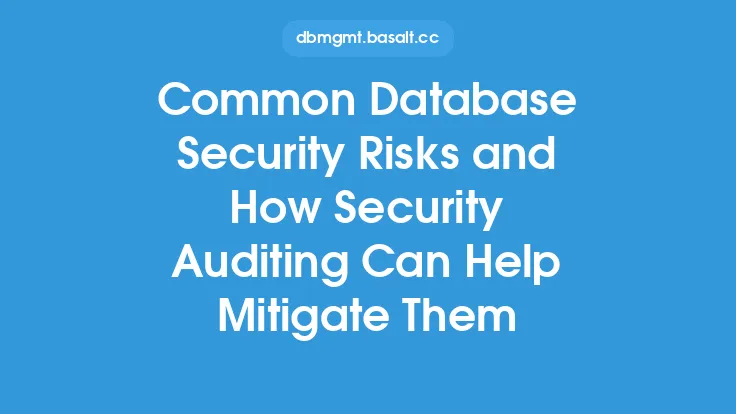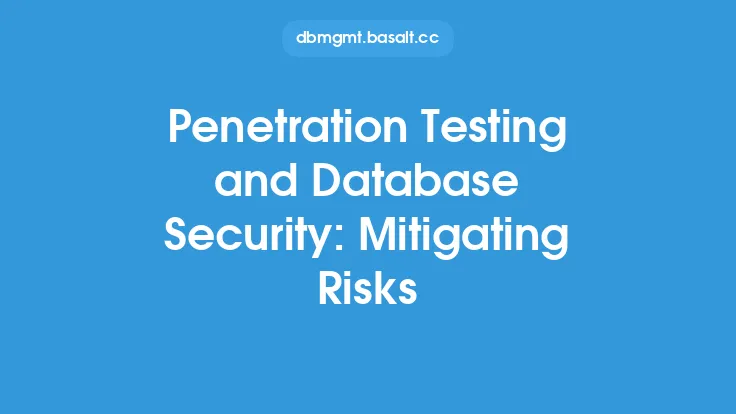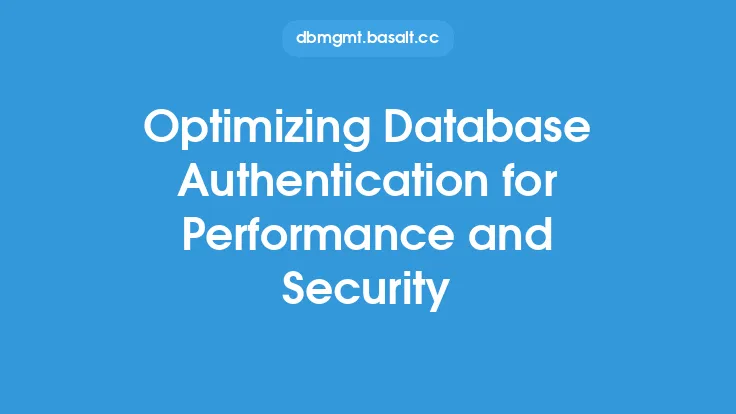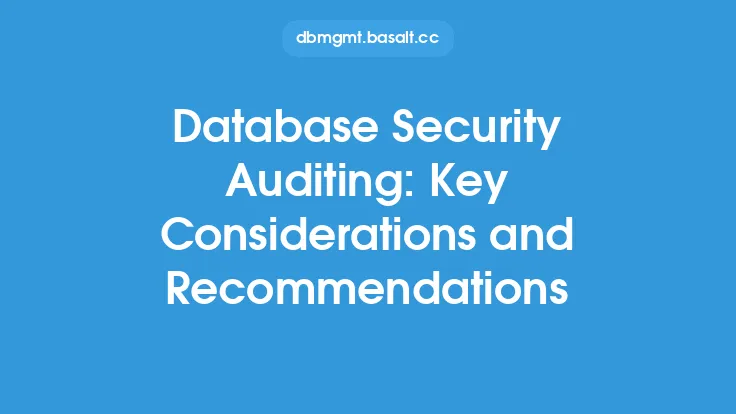Database authentication is a critical component of database security, as it ensures that only authorized users can access and manipulate the data stored in the database. However, database authentication is not without its risks, and if not properly implemented, it can leave the database vulnerable to attacks. In this article, we will discuss the common security risks associated with database authentication and the mitigations that can be put in place to prevent them.
Introduction to Database Authentication Security Risks
Database authentication security risks can be broadly categorized into two types: password-based risks and non-password-based risks. Password-based risks include weak passwords, password cracking, and password sniffing, while non-password-based risks include authentication protocol vulnerabilities, man-in-the-middle attacks, and authentication bypass attacks. These risks can be exploited by attackers to gain unauthorized access to the database, resulting in data breaches, data tampering, and other malicious activities.
Password-Based Security Risks
Password-based security risks are one of the most common types of database authentication security risks. Weak passwords, such as easily guessable passwords or passwords that are not complex enough, can be easily cracked by attackers using password cracking tools. Additionally, password cracking can be done using brute force attacks, dictionary attacks, or rainbow table attacks. Password sniffing is another type of password-based security risk, where an attacker intercepts the password as it is being transmitted over the network. To mitigate these risks, it is essential to implement strong password policies, such as password length and complexity requirements, password expiration, and account lockout policies.
Non-Password-Based Security Risks
Non-password-based security risks include authentication protocol vulnerabilities, man-in-the-middle attacks, and authentication bypass attacks. Authentication protocol vulnerabilities occur when the authentication protocol used by the database is not secure, allowing attackers to exploit weaknesses in the protocol to gain unauthorized access. Man-in-the-middle attacks occur when an attacker intercepts the communication between the client and the database, allowing them to steal sensitive information, such as passwords or authentication tokens. Authentication bypass attacks occur when an attacker is able to bypass the authentication mechanism altogether, gaining unauthorized access to the database. To mitigate these risks, it is essential to use secure authentication protocols, such as Kerberos or SSL/TLS, and to implement additional security measures, such as encryption and secure communication protocols.
Authentication Protocol Vulnerabilities
Authentication protocol vulnerabilities are a type of non-password-based security risk that can be exploited by attackers to gain unauthorized access to the database. These vulnerabilities can occur due to weaknesses in the authentication protocol itself or due to improper implementation of the protocol. For example, the NTLM authentication protocol used by Microsoft SQL Server has been shown to be vulnerable to relay attacks, where an attacker can relay the authentication request to the database, allowing them to gain unauthorized access. To mitigate these risks, it is essential to use secure authentication protocols and to keep the protocol up to date with the latest security patches.
Man-in-the-Middle Attacks
Man-in-the-middle attacks are a type of non-password-based security risk that can be exploited by attackers to gain unauthorized access to the database. These attacks occur when an attacker intercepts the communication between the client and the database, allowing them to steal sensitive information, such as passwords or authentication tokens. To mitigate these risks, it is essential to use secure communication protocols, such as SSL/TLS, and to implement additional security measures, such as encryption and secure authentication protocols.
Mitigations
To mitigate the security risks associated with database authentication, several measures can be taken. First, it is essential to implement strong password policies, such as password length and complexity requirements, password expiration, and account lockout policies. Second, it is essential to use secure authentication protocols, such as Kerberos or SSL/TLS, and to keep the protocol up to date with the latest security patches. Third, it is essential to implement additional security measures, such as encryption and secure communication protocols, to prevent man-in-the-middle attacks and authentication bypass attacks. Finally, it is essential to regularly monitor the database for suspicious activity and to implement incident response plans in case of a security breach.
Implementation of Mitigations
Implementing the mitigations discussed above requires a thorough understanding of the database authentication mechanism and the security risks associated with it. First, the database administrator must configure the database to use a secure authentication protocol, such as Kerberos or SSL/TLS. Second, the database administrator must implement strong password policies, such as password length and complexity requirements, password expiration, and account lockout policies. Third, the database administrator must implement additional security measures, such as encryption and secure communication protocols, to prevent man-in-the-middle attacks and authentication bypass attacks. Finally, the database administrator must regularly monitor the database for suspicious activity and implement incident response plans in case of a security breach.
Conclusion
In conclusion, database authentication security risks are a critical concern for database administrators, as they can leave the database vulnerable to attacks. Password-based security risks, such as weak passwords and password cracking, and non-password-based security risks, such as authentication protocol vulnerabilities and man-in-the-middle attacks, can be exploited by attackers to gain unauthorized access to the database. To mitigate these risks, it is essential to implement strong password policies, use secure authentication protocols, and implement additional security measures, such as encryption and secure communication protocols. By understanding the security risks associated with database authentication and implementing the mitigations discussed above, database administrators can help to ensure the security and integrity of the database.





